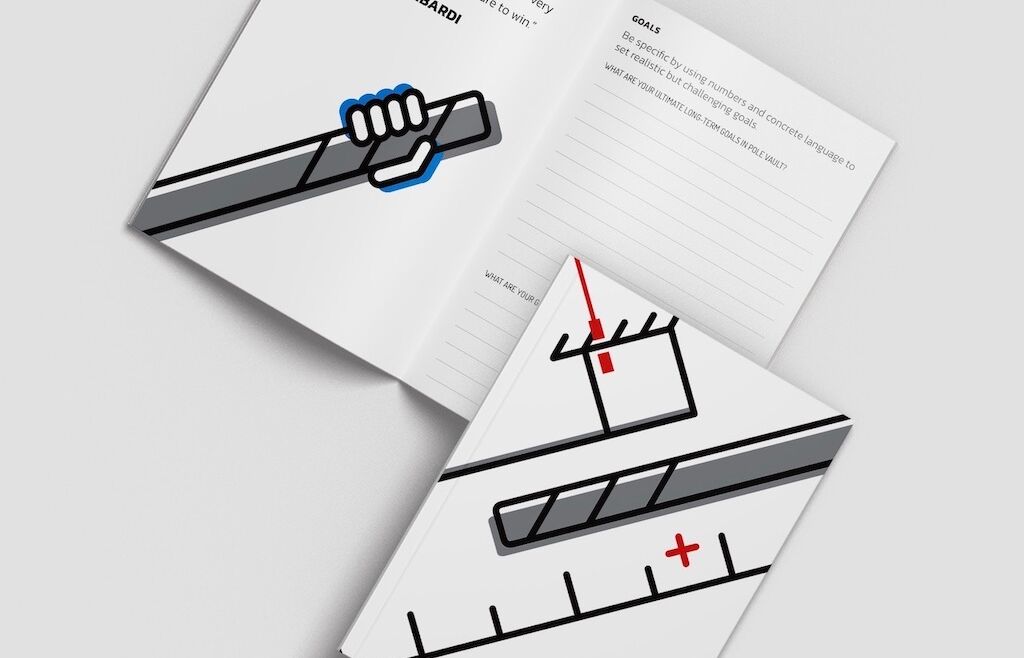If you have read the blog, 8 Reasons to Keep a Pole Vaulting Journal, you are probably wondering, “What should I keep track of in my Pole Vault Journal?”. That is a great question since we want to make sure that we are keeping track of workout data that is measurable and can be reliably counted on to keep you in line with your training plan and eventually help you accomplish your goals. What we want to avoid is empty data that really doesn’t mean very much on it’s own. An example would be a Pole Vault Journal entry like, “I cleared 17’ today”…Cool…Great job…Unfortunately, that piece of information by itself, is not that valuable and will require a good amount of context to go along with it in order to be useful. So…lets dive into what you should be writing down and keeping track of in your pole vault journal!!!
Item #1: What is your goal for this workout/meet?
We all need to be setting daily, weekly, monthly, annual, and career goals in order to become the best we can be in the pole vault. If you are doing it right, you and your coach should have a training plan written up which will become the the roadmap to reaching your goals. Your training plan should be a periodized plan that shows everything that you will be doing throughout the whole season. This piece obviously changes as the challenges of each particular season come up, but you should be able to pick a day of the year, and your coach should be able to tell you what you will be doing on that day. This piece is very important, and if you do not have this, I would sit down with your coach and get your plan written out. If you are lucky enough to be a part of a program that has a well defined system of instruction and has your training all written out, you need to become familiar with it so you can start logging your workouts according to that plan and be able to recognize when you are getting off track. For each day, you and your coach need to pick a workout goal. This goal should align with your weekly goals and should be how you judge your workout as successful or unsuccessful. Write it down and get after it!!!
Item #2: The date of your workout
This seems so simple, but it is really important. You want to take it a step further? Put down the time of day you are training. Providing the date that you do something is really going to have a great impact when you go back to reflect on your past training in order to make better decisions for your future training. If you are feeling beat up and maybe your shins hurt, it would be very helpful to know exactly how many days ago your coach made you do a million wind sprints on the tile floor in your school’s hallway. If it was two days ago, that workout is most likely the culprit and you would need to adjust your future workouts accordingly. If that workout was three weeks ago, that workout may not have as big of an impact on your current state as you might think and something else in your training may be causing the issue. Knowing specific dates of when you alter training really helps to understand how your body is reacting to it, and without a specific date, you may just be guessing as to why you are feeling a certain way.
Like I said earlier, the time could be something of value too. If you look at your performance on one day compared to another day, you might see that a workout at 5 AM may be a little sub par when compared to the same workout at 5 PM. If you can notice things like this about your training, you can analyze the effectiveness of workouts more accurately and prepare yourself better.
Item #3: Approach Length
This should actually be two different metrics, the number of strides (or lefts) that you are taking, and the actual length in feet and inches on the runway. If you are logging workouts in a Pole Vault Log Book, I like to split this box into two boxes and write in the numbers like that.
It is important to note what approach you are running from for the obvious fact that you will generally vault a little lower from a shorter approach than you will from a longer approach. This is not always true as Derek Miles, our guest of episode sixteen of the One More Jump Podcast discusses, but like I said, this is generally the case. You could see how it would be disappointing it would be to look back on a workout that you were vaulting two feet lower than your personal best without the context that you were running a short approach that day.
Your approach length can change from day to day, especially with beginners. As you become a more advanced vaulter, your approach length should become much more consistent, but this is still a relevant metric since a half of a shoe back on your approach can mean a lot for an elite vaulter. In beginners we often see vaulters run through (not get off the ground) a couple times in a vault workout and are then met with a blank stare when we ask them a simple question, “Where were you running from the last workout?”. When they can’t provide that number, we quickly realize that the issue is in the fact that they don’t remember where they were running from. This issue can easily be avoided by writing down your start mark on every vault of every workout.
Item #4: Pole Size
The bigger the pole you get on the easier it is going to be to vault higher. This is generally a steadfast rule, although I did see a dude vault 13 feet on a 16 foot long pole one time. That rule didn’t workout very well for him unfortunately. So if we know that getting on bigger poles is going to have a high correlation with pole vaulting higher, it would be wise to write down in your pole vault journal what length and weight rating the poles are that you are using in your workouts and meets. If you want bonus points, log the flex number as well. If you don’t know what the flex number is, you probably don’t need to worry about logging it, but your time will come. I think that most coaches would say that when vaulters start moving bigger poles, they are probably going to vault a big bar soon. Writing a pole down in your pole vault journal that you have never vaulted on before can be extremely motivating and really start a snowball of momentum towards a personal best. On the flip side, if you are starting to notice your pole size trending in the opposite direction, you may want to look at the other areas of your training log to see what may be causing that.
Item #5: Grip
Pole size and grip are the tag team that are usually responsible for your shiny new personal bests, so making sure to write down your grip will be another very important metric to record in your pole vault journal. It is important to always look at the correlation between your grip and another metric we will talk about later which is the take off mark. It is important to try and maximize the amount of physics you have working for you in the pole vault, and making sure that your grip is matching up with your take off mark is always super important for the proper execution of your technique, but also to keep your body type for pole vaulting healthy and injury free. Taking off too far underneath your top hand for long periods of time can really stress your body a lot, and it is not advisable to do for many workouts in a row. Some workouts it may be unavoidable and in meets it is difficult to stay disciplined over your last five strides and not hit under, but make sure you are trying minimize the number of times you take off too far under.
Grip is also a big player in the timing of a pole. Everyone has seen the “over gripper”. These vaulters grip WAY too high and make poles scream and beg for mercy when they rock back on them and have a hard time not over rotating in the pit if they are so lucky to not end up making a trip to the box. Also, we have the under gripper that looks kind of like a hybrid between a straight poler and a bender. Both of these methods do not yield the best results and the proper grip for your timing should try and be found. For every pole and every pole vaulter there is a different “sweet spot” where the grip matches up most efficiently with the vaulter’s timing, and tracking this may help for you to better understand this in your own vault.
Item #6: Bar Height/Drill
Next is a fairly obvious one, the height of the bungees or bars that you are vaulting at. This is the metric that we are all trying to improve, so it is important that you track it. As you are vaulting in your workout and putting down the height of the bar/bungee that you are vaulting at, I think that you should put two little tags next to that entry.
The first would be if it is a bar or bungee. Unfortunately this makes a difference in a lot of vaulters. The goal is to always vault at a bar and bungee the same, but everyone knows deep down inside that you vault at a bar a little different than a bungee. Hats off to you if you don’t, but I think this applies to the majority of pole vaulters, just being honest. Now we could get into a mile long separate blog post arguing which one is better for you to vault at during practice, but I think that there is a simple answer to that question, you should do a little of both. I can feel the wheels turning in my head right now, and I am tempted to get into this argument, but this post is not about when or why to vault at a cross bar or bungee, this post is about how to keep an effective training journal, so we will keep the simple answer of…you should do a little of both. To differentiate between a bar or bungee in your pole vault journal entry, just put a “B” for bungee or a “CB” for cross bar next to the height you are vaulting at.
The second tag that I would suggest putting on this height entry would be an “X” for a miss and a “O” for a make. This is important because you need to make sure that you are making a bar or bungee during your workouts. Everyone knows the person who “has to have something to shoot for” in every workout. They put the bungee like two feet higher than their personal best and are probably the person who breaks all the bungees too. I understand that there is some value in putting up a high bungee to try and force a vaulter into a stronger inverted position, and it is fun to wrap big bungees, but when someone says, “I need to have a bungee to shoot for”, that sounds like a weakness to me. I have never seen Mondo ask an official to put a bungee at 22 feet so that he has “something to shoot for” when trying to break the world record. I’m pretty sure you can’t do that in a meet, so learning how to vault the same regardless of the bungee height seems more advantageous. Moving on…There is great value in making sure to “no touch” a bungee in your workouts. Clearing bars without touching them is the premise of our sport and creates good habits with the added bonus of improving confidence. If you are always pulling bungees down and never going completely clear of them, you may be practicing bad habits like dragging your arms, not finishing your vault fully, and not learning the ever important skill of not hitting the bar, so make sure that you are tracking your makes and misses. If your misses are far outnumbering your makes, lower the bungee and go fully clear of it.
If you are not vaulting at a bungee or a bar, make sure to write down what drill you are working on, and maybe put a simple “x” or “o” if the drill was performed effectively.
Item #7: Standard Placement
This is something that is very important, but often over looked. Most of the time, an athlete will be working out with their standards all the way back (80cm). Vaulting with your standards all the way back really helps to practice good habits of moving the pole and forces you to be on a pole that is soft enough to free your mind of landing shallow. When you mind is free of the thought that you may not make it into the pit, it has more capacity to think of the actual technical cues you are working on. That being said, I believe there is some value in bringing in your standards every once in a while at practice to put your vault onto some bigger “meet” poles. In this case it is important to track where your standards are placed so that you can place them properly when you go into a meet.
While I am on this topic. Make sure you know what your standards are placed at regardless if you are in practice, at warm ups during a meet, and of course when you are taking a competitive vault at a meet. One big problem that we see a lot is athletes not speaking up during the warm up at a meet to have their standards placed in a specific spot. SPEAK UP and get your standards in the proper pole vault standards placement during your warm up. The whole point of warming up at a meet is to get all of your numbers (grip, pole size, pole vault standards placement, opening height) dialed in so that when you take your first competitive vault, you are successful. Too many times the athlete warms up and has no clue where their standards are placed, and then when the official asks them where they want their standards on their fist competitive vault, they have no clue where to put them. Don’t be that guy or girl.
So long story short, make sure that you mark in your pole vault journal where your standards are placed for every vault you take.
Item #8: Take Off Mark
We mentioned earlier the importance of the take off mark and the grip height lining up properly. Making sure that you are taking of “on”, or with the ball of your foot directly underneath your top hand, is very important for kicking your swing into hyper drive, and as equally important for keeping your back and other joints healthy. It is very important to track this metric and keep an eye on it. If you start creeping towards 50% of your take offs being substantially under, you really need to figure out how you are going to get it closer to “on”. Unfortunately that can be a difficult task at times. A good coach will be able to adjust your start mark or give you technical cues on your run to make this take off mark come in or out. If you don’t have an experienced coach, be careful, because the run is a tricky thing to coach and adjust at times. If you don’t have a highly trained eye the run can trick you. For example, sometimes a vaulter may be taking off “under”, but they need to move their run even closer to the pit to solve the problem since they are striding out during some part of their run (usually the end). If you don’t have an experienced coach, they may continue to move mark back thinking it will pull that take off mark out, but it is actually making the problem worse. Moral of the story, get lined up with an experienced coach that knows what they are doing and log your take off mark after every vault. Bonus points for averaging them at the end of the workout to find your average take off.
Item #9: Miscellaneous
One great design feature in the Pole Vault Log Book is a simple one, a blank metric of your choice. Everyone is in different phases of pole vault journey and this opens up the ability to add something very specific to your developmental level. Some examples of metrics to put here would be a mid mark, velocity over last five meters of the run, or a specific goal that you are working on. Some people live and die by their mid mark and I think that a “mid” is a pretty important metric for people who are at advanced stages of vaulting. If you don’t know what a mid mark is, you probably don’t need to track it.
I think the best use of this miscellaneous space is to put a specific, process oriented goal. For example, I was always on the quest for my take off mark to be consistently outside thirteen feet. I knew that if I could consistently do this, I could consistently grip sixteen feet allowing me to consistently clear 5.50m (18’ 1/2”). The correlation between my take off mark being outside of 13 feet and me vaulting well was very high, so this was always a huge focus in all of my workouts, and I would take that process oriented goal and put it in the miscellaneous space of my pole vault journal. In order to lighten up the mood, I would then put a smily face if my take off was outside of thirteen feet, and a sad face if it wasn’t. At the end of the workout, I would add up my smily and sad faces to see what percentage of the workout I was successfully accomplishing my goal. This was a great way for me to stay focused on my process goals that would eventually lead to my outcome goals.
Item #10: Reflection/Performance Summary
This is probably the most important part of your pole vault journal. All of this data that you are accumulating means nothing without reflecting, analyzing, and then applying your findings to the improvement of you next workout. Don’t over complicate this section, it can be as simple as the following…Did you accomplish your goal for the workout? What caused you to not reach your goal? What adjustments can you make to your next workout to realign yourself with your goals for this season?
I think that it is important to not drown your page in negativity. It is imperative that you are honest about your workout and write down when things didn’t go your way, but there is a difference between recognizing that you didn’t accomplish your goal for that day, and being mean to yourself. If you are starting to see entries like, “You suck”, “Stop being a baby”, or things like this…STOP…that isn’t doing anything for you…. In order to curb this type of behavior, I think that it is always good to end your pole vault journal entry with some thing positive. “I’m so happy that I was injury free today”, or “I am so excited about the meet this weekend”.
Now you know how to keep a pole vault journal!
There are many more things that you could track in your pole vaulting journal outside of the things discussed in this blog, but this is a good start. I would encourage you to find what metrics move the needle of improvement for you and track those. Taking the time to start gathering data on your own vault is going to help you make the process of improving so much more streamlined and efficient. Two little bonus tips that I would like to mention is to make sure that you stay consistent with it and to save your journals. Make this a habit that you commit to every single workout. The more data you have, the more accurate your training adjustments are going to be. Don’t make it too complicated that it becomes a hassle and you stop doing it. Consistency is key in journaling your training. The last bit of advice would be to keep your pole vault journal and never throw them away. They are so much fun to look back on as you get older, and are packed full of great information that can be applied to other areas of your life, and better yet, passed on to the next generation of pole vaulters. Now go out there at start journaling!




